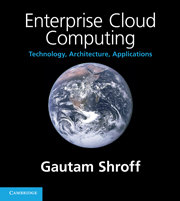Book contents
- Frontmatter
- Contents
- Preface
- List of abbreviations
- Part I Computing platforms
- Chapter 1 Enterprise computing: a retrospective
- Chapter 2 The internet as a platform
- Chapter 3 Software as a service and cloud computing
- Chapter 4 Enterprise architecture: role and evolution
- Part II Cloud platforms
- Part III Cloud technologies
- Part IV Cloud development
- Part V Software architecture
- Part VI Enterprise cloud computing
- References
- Index
Chapter 4 - Enterprise architecture: role and evolution
Published online by Cambridge University Press: 06 December 2010
- Frontmatter
- Contents
- Preface
- List of abbreviations
- Part I Computing platforms
- Chapter 1 Enterprise computing: a retrospective
- Chapter 2 The internet as a platform
- Chapter 3 Software as a service and cloud computing
- Chapter 4 Enterprise architecture: role and evolution
- Part II Cloud platforms
- Part III Cloud technologies
- Part IV Cloud development
- Part V Software architecture
- Part VI Enterprise cloud computing
- References
- Index
Summary
As technology evolved from mainframes through client-server to the internet era and now to cloud computing, each large enterprise has had to continuously evaluate emerging architectures and plan the evolution of its IT environment, at the same time ‘keeping the lights on’ by ensuring stable IT systems to support running its business. In this process, each IT department has become characterized by a mix of technologies, as a continuous balancing act is maintained between the stability of legacy systems, demands of new business requirements and the adoption of new technologies.
The ‘enterprise architecture’ function within enterprise IT has evolved to manage the complexities of an ever-changing technical environment. In the process enterprise architects found it useful to maintain a description of all of an enterprise's software applications, how they fulfill business needs, how they are implemented technically and how they communicate with each other. Additionally, defining and enforcing technical standards to guide the choice of new technical platforms has become another integral part of this function. To examine how cloud computing can and will be adopted in large enterprises, we need to view this potential paradigm shift from the perspective of the enterprise architecture function.
ENTERPRISE DATA AND PROCESSES
Information systems, by definition, need to keep track of the core information vital to the functioning of an enterprise.
- Type
- Chapter
- Information
- Enterprise Cloud ComputingTechnology, Architecture, Applications, pp. 39 - 48Publisher: Cambridge University PressPrint publication year: 2010
- 1
- Cited by



